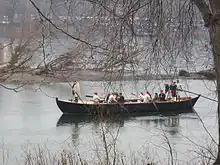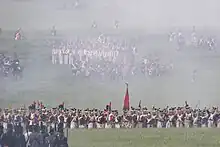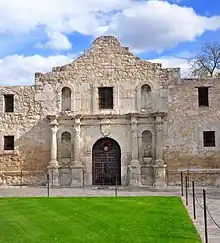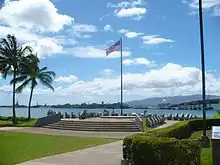Military tourism
Tourism for old war zones and sites of battles
Military tourism is for those with an interest in current or historical military sites and facilities, including museums, battlefields, cemeteries and technology.
Almost any capital city and many other cities and towns will have some sort of monument for the fallen, and many museums include weapons or paintings of war (making up a whole genre of European art). This article tries to cover the specifically military sites beyond that.
Understand
| “ | War. War never changes. | ” |
—Fallout series | ||
Wikivoyage has articles on some ancient empires — Alexander the Great, Persian Empire, Roman Empire, Imperial China, Mongol Empire — and more recent colonial empires — British Empire, Portuguese Empire, Spanish Empire, French colonial empire — and all of these include some military history. So do many country or city articles.
The articles on castles, the crusades and spies and secrets are also related.
The Flashman Papers are comic historical novels about a cowardly British officer in Victoria's time, with accurate military history.
Destinations
Ancient conflicts
- See also: Roman Empire, Ancient Greece
- The Battle of Kadesh, fought in 1274 BC between the Hittites and Ancient Egyptians in what is now Syria, is the best documented ancient battle thanks to extensive contemporary inscriptions. It ended in the earliest known peace treaty, and the only ancient Near Eastern treaty with both versions surviving: the Egyptian version can be seen engraved partly on the walls of Karnak Temple and partly on the pylons of the Ramesseum in Luxor, while the three tablets bearing the Hittite version were found in the Hittite capital Hattusa; two of them are now exhibited in the Archaeological Museum of Istanbul and the other in the Museum of the Ancient Near East in Berlin. A replica is displayed at the UN Headquarters in New York City.
- Kurukshetra, near Delhi, was the site of a great battle described in the epic Mahabarata.
- The Trojan War over 🌍 Troy in today's Turkey is a foundation myth of Ancient Greece, through the Iliad and the Odyssey. The war was supposedly fought in the 12th century BC, and while the epics were full of supernatural elements, the depiction of warfare is remarkably realistic.
- Alexander the Great conquered the Persian Empire in the 4th century BCE. He never lost a battle and his tactics are still studied.
- Gaoping in northern China was the site of the Battle of Changping, a major military campaign between the State of Qin and the State of Zhao between 262 BC and 260 BC. There is an archaeological museum at the site of the battle and an exhibition on the battle can also be seen at the Jincheng Museum in Jincheng.
Middle Ages
- See also: Medieval Europe, Islamic Golden Age
- Karbala in Iraq was the site of a battle in 61 AH (680 AD) in which Hussein, grandson of the Prophet, was killed. There are shrines, tombs and mosques of great significance to Muslims, especially Shi'a.
- In the 13th century CE, the Mongol Empire conquered all of the Chinese and Persian empires, most of what is now Russia, and other parts of Europe and the Middle East.
- Bannockburn Battlefield, in Stirling, Scotland, one of the most important battles in the history of Scottish independence
- Vikings and the Old Norse
- Crusades
- The Fall of Constantinople in 1453 marked the end of the Middle Ages, and proved the superiority of gunpowder use over even the most complex defensive fortifications.
Age of Discovery and Early modern Europe
- Thirty Years' War: One of the most destructive wars to ravage Europe, especially its center. Certain aspects are still commemorated on an annual basis or for "round" anniversaries.
- Lützen is the site where Gustav Adolph of the Swedish Empire, head and biggest hope of the Protestant camp, met an untimely death in battle
- Rothenburg ob der Tauber still holds the "Meistertrunk" in commemoration of an event when the mayor saved the town by downing a big mug of wine in one gulp
- Fortifications of Vauban fortifications around the French borders built during the reign of Louis XIV, 12 of which are listed as a world heritage site
American Revolution
- See also: Early United States history

- The Freedom Trail is a 2.5-mile redbrick walking trail that makes its way to 17 of Boston’s most historic sites which together tell the story of the American Revolution.
- The First Presbyterian Church in Morristown NJ was a hospital for soldiers; Washington crossed the Delaware River at Titusville (New Jersey) to enter Pennsylvania.
- Plattsburgh NY was the site of the Revolutionary War's Battle of Valcour Island and the War of 1812's Battle of Plattsburgh. Fort Ticonderoga NY was captured by Ethan Allen’s Patriots under cover of darkness in 1776 as part of a siege during the Revolution.
- Various historic sites in the United States National Park System commemorate portions of the war. George Rogers Clark National Historical Park in Indiana commemorates the capture of Fort Sackville from British forces in 1779, this allowed George Rogers Clark to march to the Mississippi River.
- Colonial Williamsburg re-creates 18th-century Williamsburg as it appeared preceding and during the American Revolution.
- Annapolis Royal in Nova Scotia has faced a total of thirteen attacks during its long history, including a raid during the American Revolution. After the war, it became home to United Empire Loyalist settlers.
Napoleonic wars

- Austerlitz Battlefield, near Brno, Czech Republic, site of one of Napoleon's greatest victories, and one of the most important battles of 19th-century Europe.
- Cabo de Trafalgar, in Cadiz province, Spain, the site of a famed naval battle battle in which the British defeated a combined French and Spanish force, thus scuttling Napoleon's plan to dominate the seas, and cementing the United Kingdom's place as the dominant naval power of the 19th and first half of the 20th centuries. Trafalgar Square in London commemorates Admiral Horatio Nelson, the commander of the victorious British forces who was killed in the battle.
- Waterloo Battlefield, at Waterloo, Belgium, where Napoleon lost his final battle against a combined British and Prussian force.
- There is a truly bombastic (built for the first centennial) monument for the 1813 Battle of Leipzig
War of 1812
- Main article: War of 1812
With the Napoleonic Wars raging in Europe, perhaps colonial powers of the era could be kept distracted at this point in early United States history for long enough for the US to attempt an invasion of Canada?
- Ireland Island, established in 1809 as a British naval base in Bermuda, supplied British ships in the War of 1812 and the American Civil War.
- Various installations directly on the Canada-US international boundary date to this era, or were constructed in the immediate aftermath of this conflict. The Niagara Peninsula was a key battleground; Fort York in Toronto and Fort Wellington in Prescott (Ontario) also defended Upper Canada. Much of the Windsor-Quebec corridor was dangerously exposed, given its southern geographic location. Lewiston (New York) was burned to the ground; Champlain and Rouses Point were used as a staging area for attacks on Canada from Plattsburgh NY.
- Sackets Harbor NY on Lake Ontario successfully fended off two British-Canadian attacks, only to knock itself out of much of the war - burning their own supplies for fear of them falling into British hands. Fort Ontario in Oswego was a US stronghold on the lake; Essex (New York) was an important ship building yard.
- Fort McHenry is immortalised in the "Star Spangled Banner" anthem for defending Baltimore Harbor and Chesapeake Bay from a British naval attack on September 13–14, 1814.
- Remains of Fort Madison's War of 1812 and Civil War fortifications are visible in Castine, Maine.
- The war ended on December 24, 1814. Word travelled slowly in this era, leaving one last battle (the 1815 Battle of New Orleans) to be fought near Chalmette. Andrew Jackson won this battle for the US, but the War of 1812 was already over.
- The Rideau Canal was constructed after the war to divert Canadian domestic shipping through Ottawa. While the 1813 Battle of Crysler's Farm (near Morrisburg) was a British-Canadian victory which kept the river open for British ships, the St. Lawrence River (a key transport corridor which is part of the Ontario-NY border) continued to be perceived as vulnerable in the aftermath of the war.
American Civil War
- Antietam National Battlefield and Cemetery, in Sharpsburg, Maryland, site of the battle which became the bloodiest day in American military history.
- Batteries F and Robinett and the Beauregard Line, in Corinth, Mississippi
- Fort Donelson National Battlefield and Cemetery, in Dover, Tennessee, site of an early battle which pushed the Confederates out of central Tennessee.
- Gettysburg National Military Park, in Gettysburg, Pennsylvania, the site of North America's biggest battle and a turning point in the American Civil War.
- Kennesaw Mountain National Battlefield Park, in Kennesaw, Georgia, a preserved battleground featuring 11 miles of Union and Confederate earthworks.
- Manassas National Battlefield Park, in Manassas, Virginia, site of the First and Second Battles of Manassas, also known as the First and Second Battles of Bull Run.
- Mansfield State Historic Site, in Mansfield, Louisiana, is a preserved battleground and site of one of the largest Civil War battles west of the Mississippi River.
- Monocacy National Battlefield, in Frederick, Maryland, site of a summer 1864 battle between General Jubal Early of the Confederacy and General Lew Wallace of the Union.
- Pamplin Park and the National Museum of the Civil War Soldier, in Petersburg, Virginia, commemorating the siege and fall of Petersburg which led to the Lee's final surrender at Appomattox Courthouse.
- Richmond, Virginia, capital city of the Confederacy, is home to Richmond National Battlefield, the White House of the Confederacy, the Museum of the Confederacy, and other historic points.
- Stones River National Battlefield, in Murfreesboro, Tennessee.
- Tupelo National Battlefield, in Tupelo, Mississippi
- Vicksburg National Military Park, in Vicksburg, Mississippi, site of a 47-day siege in mid-1863.
Other American wars

- See also: Old West, Postwar United States
- The Alamo in San Antonio, site of the most memorable battle of the war for Texas independence.
- Custer Battlefield Museum, in and around Billings, Montana, including all of the locations associated with the Battle of the Little Bighorn in 1876, also known as Custer's Last Stand. The actual battlefield is on the Crow Agency reserve.
- Wounded Knee, site of an 1890 massacre of several hundred Sioux by Custer's old regiment, the Seventh Cavalry.
Opium Wars
- See also: Imperial China
- Opium War Museum, in Humen, at the site where Lin Zexu destroyed large quantities of smuggled opium, an event that precipitated the First Opium War.
- Sea Battle Museum, a museum about the naval battles of the Opium Wars, near the Weiyuan Fort in Humen, one of several forts used to defend the Humen Strait during both Opium Wars.
- Memorial to the Sanyuanli People's Struggle Against the British , in Baiyun District, Guangzhou. A memorial dedicated to the Sanyuanli Incident, an uprising by local civilians against the British Army in 1841.
- Museum of the Treaty of Nanking, part of the Jinghai Temple Museum in Nanjing. The Jinghai Temple was where the British and the Qing government negotiated the terms of the Treaty of Nanking.
- Taku Forts (Dagukou Forts), in Tianjin, the site of several battles during the Second Opium War. Only one of the Taku Forts has been restored and it doesn't look much like it did during the Opium Wars. However, there is a decent museum next to the restored fort.
- Old Summer Palace, in Haidian District, Beijing. The palace was looted and destroyed by Anglo-French forces in 1860 at the end of the Second Opium War. It has been preserved in a state of ruin by the Chinese government as a stark reminder of China's "Century of Humiliation".
Flashman and the Dragon is a historical novel with accounts of both the taking of the Taku Forts and the burning of the Summer Palace.
World War I
- Anzac Cove, Gallipoli, Turkey, a defining place for the Australian and New Zealand nations.
- Vimy Ridge, near Arras, site a major battle fought mainly by Canadian troops, with a large memorial
- The village of Thiepval near Albert in Picardy has a memorial for over 70,000 British and Empire troops who have no known grave but fell during the three Battles of the Somme, 1915-1918. There is a memorial service on July 1 every year.
- The In Flanders Fields Museum in Ypres, Belgium
- Armenian genocide remembrance
- Russian Revolutions and Civil War: see Soviet Union
- In East Africa a German force, surrounded by colonies of hostile powers and badly outnumbered, fought a brilliant guerilla campaign and did not surrender until after the German surrender in Europe.
Between the World Wars
- The Chinese Revolutions from 1911 to the 1970s included the Long March, a retreat in 1934-35 that has been called "the founding myth of Communist China".
- The museum in Mongolia commemorating the Battle of Khalkhin Gol in 1939, in which a combined Soviet and Mongolian force succeeded in defending the border in return for more casualties. This turned Japanese thought toward striking south instead of grabbing Siberia, so it influenced the later war.
World War II
Pacific War

- Atomic museums and memorials of Hiroshima and Nagasaki, cities hit by the two atomic bombs which heralded the end of the war.
- The Kokoda Track, in Papua New Guinea, an important battle line between Australia and Japan.
- Okinawa Peace Park and Himeyuri Monument, in Naha, Japan
- Pearl Harbor, site of the bombing east of Honolulu that caused the United States to enter the war.
- Burma Road, bringing supplies to beleaguered China
World War II in China
The conflict between China and Japan began in 1937, and over time became entangled with both World War II and the Chinese Revolutions.
- Nanjing Massacre Memorial in Nanjing
- Whampoa Military Academy in Guangzhou was China's premier military academy during the Republic of China era, and trained many distinguished Chinese generals, both Nationalist and Communist, who fought the Japanese in World War II. The campus of the former academy is now a museum.
World War II in Europe
- Babyn Yar Monument and German Military Graveyard, in Kyiv, Ukraine.
- Churchill War Rooms and the HMS Belfast, in London, England.
- D-Day beaches in Normandy, sites of the Allied invasion of western Europe.
- Bletchley Park, near Milton Keynes, was the headquarters for British codebreakers who were very successful against German ciphers, notably the Enigma machine. There is a museum.
- Dieppe, on the coast of France, has a monument for a 1942 raid by mainly Canadian forces
- Volgograd, actually renamed Stalingrad for a few days a year, was the scene of one of the largest battles in World War II. The memorial, "The Motherland Calls" on top of Mamayev Kurgan hill over which intense fighting occured is the world's largest non-religious statue.
- Brest fortress in Belarus
- Amsterdamse Waterleidingduinen in Zandvoort hosts a wide variety of bunkers of the German Atlantikwall in a beautiful natural landscape.
World War II in Africa
Holocaust remembrance
- Auschwitz-Birkenau, near Oświęcim, Poland. Perhaps the most infamous cluster of concentration/labor/extermination camps.
- Sachsenhausen concentration camp, in Oranienburg, Germany
Other Asian wars
- Taiping Kingdom Museum, in Nanjing. A museum about the Taiping Rebellion in 19th century China.
- Museum of the First Sino-Japanese War, in Weihai, China.
- Guandu Battleground (官渡古战场),Zhengzhou, Henan, China — the site of the Battle of Guandu towards at end of the Eastern Han Dynasty, when the warlord Cao Cao scored a decisive victory over the numerically superior forces of his main nemesis Yuan Shao, thus allowing him to consolidate his rule over most of northern China, thus setting the stage for the kingdom of Wei to be declared by his son Cao Pi following his death.
- Chibi (赤壁) Hubei, China — the site of the Battle of the Red Cliffs during the Three Kingdoms period, when an alliance between the warlords Liu Bei and Sun Quan defeated the numerically superior forces of Cao Cao, who had already consolidated his rule over northern China, thus preventing him from expanding south of the Yangtze River.
- Sekigahara, Japan, where Tokugawa Ieyasu defeated loyalists of the Toyotomi clan in the pivotal Battle of Sekigahara in 1600, allowing him to unify all of Japan under his rule.
- Wando, South Jeolla, South Korea — site of the annual Myeongnyang Battle Festival, where the Battle of Myeongnyang of 1597, perhaps the most famous battle during the late 16th century Japanese invasions of Korea, is re-enacted. During this battle, the Korean navy under the command of Admiral Yi Sun-shin defeated the numerically far superior Japanese navy, thus cementing Admiral Yi's position as a national hero in Korea.
Cemeteries

- 🌍 Arlington National Cemetery, in Arlington, Virginia is the most important military cemetery in the United States
- The world's only United Nations cemetery in Busan, South Korea. The resting place for many soldiers who fought under the UN in the Korean War
- Around 100,000 men died in Normandy in the summer of 1944, and most are buried there.
- Wagga Wagga War Cemetery is the most important military cemetery in Australia
Museums of military vessels, aircraft and vehicles
See Military sites and museums in Australia for sites in Australia.

- The British National Maritime Museum (Greenwich) and Imperial War Museum (Southwark) in London, England
- The Seattle Museum of Flight has a range of military aircraft including a Lockhead SR-71 'Blackbird', the fastest manned aircraft in the world
- USS Nautilus, the world's first nuclear powered submarine, on display in Groton, Connecticut
- Portsmouth Historic Dockyard, in Portsmouth, England, home to historic British military naval vessels such as the Mary Rose and HMS Victory. The HMS Victory was the flagship of Vice-Admiral Horatio Nelson during the Battle of Trafalgar (1805), where he was killed in action, and the oldest naval ship still in commission.
- The aircraft carrier USS Intrepid has been converted into a museum in Manhattan, New York
- The Vasa Museum, Stockholm/Djurgården, with the world's only preserved 17th century warship
- The deutsches Museum in Munich displays an original V2 rocket.
- The Maritime Museum in Quanzhou has many relics from Chinese trading and naval vessels up to the early 1400s when the Emperor shut down the expeditions; see Voyages of Zheng He and Maritime Silk Road. Marco Polo sailed home from here. Both Kublai Khan's unsuccessful invasion of Japan in the 13th century and Koxinga's successful invasion of Taiwan in the 17th were launched from this port.
- Ottawa has the Canadian Aeronautical Museum and Canadian War Museum.
- The USS Constitution is the world's oldest commissioned naval vessel still afloat. It is usually docked in the Charlestown Navy Yard in Boston, but may sometimes sail for special occasions.
- 🌍 German Tank Museum (Munster near Soltau, Lower Saxony, Germany). Headquartered in an old military town (which was basically a village before the army set up shop here) this museum tries to show the history of four German armies (Imperial, Nazi, East German, postwar West German and reunified) but of course most visitors come for the roughly 1/3 of the exhibition that shows Wehrmacht tanks.
- 🌍 Heeresgeschichtliches Museum (Vienna, Austria). A museum on wars involving the Habsburg monarchy, including exhibits like the car in which Franz Ferdinand was shot in Sarajevo 1914 or the blood stained order of Thirty Years War general Wallenstein to Pappenheim to intervene in the Battle of Lützen which led to the latter's death.
- 🌍 Musée des Blindés (Saumur Tank Museum) (in Saumur, France).
- 🌍 Kollaa and Simo Häyhä Museum (in Rautjärvi, Finland). Museum's focus is battles of Kollaa front during the Winter War. The permanent special exhibition is dedicated to the deadliest sniper in history, Simo Häyhä (1905–2002), who was also known as the "White Death". (updated May 2024)
- 🌍 Kubinka Tank Museum.
- The Bomber Command Museum of Canada, Nanton, Alberta. Many of Britain's aircraft for World War II were built in Canada, perhaps most notably the Avro Lancaster which was the mainstay of RAF Bomber Command.
- 🌍 Museo del Ejercito y Fuerza Aerea (Museum of the Army and Air Force), Guadalajara, Mexico. Originally a barracks and military academy, the facility was renovated in the late 1990s and opened in 1999 as a museum documenting Mexico's military from its evolution from a colonial Spanish army to its complex and evolving role in providing for the national defense. 15 galleries highlight historic conflicts while providing displays of flags, uniforms, tanks, jeeps, artillery and other military equipment.
- 🌍 Museo Militar de Aviación (Museum of Military Aviation), Zumpango, [Mexico State]] (at Mexico City - AIFA Airport (NLU)). Aviation museum displaying a variety of planes and helicopters from the early days of aviation through the modern era. Foreign visitors will find numerous surprises including Mexican made Aircraft from the early 20th century (the age of bi-planes). Very modern museum. Free admission..
Military academies
Virtually all countries with militaries have academies dedicated to training their commissioned officers. Some of these have beautiful historic campuses which are open to visitors, though a guided tour may be required to visit them.
- 🌍 United States Military Academy (West Point, New York). The main officer cadet school for the United States Army. The academy has produced countless American military and governmental leaders, and its historic and scenic neo-Gothic granite campus can be toured only by guide which can be arranged at the visitor's center for a fee.
- 🌍 United States Naval Academy (Annapolis, Maryland). The main officer cadet school for the United States Navy and Marines. Founded in 1845, its impressive campus on the Chesapeake Bay is steeped in history, monuments, and military tradition. Tours are available year round during regular visiting hours (9AM to 5PM daily), but access to the campus requires a valid picture ID for those over the age of 16.
- 🌍 United States Air Force Academy (Colorado Springs, Colorado). The main officer cadet school for the United States Air Force and space Force. Founded in 1954, it does not have the same classical-style buildings of some of the other academies, but the campus is located in an area with breathtaking scenery, and the Cadet Chapel is widely regarded an icon of modernist architecture. Tours are available year round during regular visiting hours (9AM to 5PM daily).
- 🌍 Royal Military Academy Sandhurst (Sandhurst, England). The main officer cadet school for the British Army. Guided tours may be booked in advance by visitors.
- 🌍 Britannia Royal Naval College (Dartmouth, England). The main officer cadet school for the Royal Navy. Guided tours are available for visitors.
- 🌍 Royal Air Force College (Cranwell, England). The main officer cadet school for the Royal Air Force. Guided tours are available for visitors but must be booked way in advance.
- 🌍 Royal Military College, Duntroon (Russell, Canberra). The main officer cadet school for the Australian Army. Visitors may walk around the campus but may not enter the buildings. Also the has the original Changi Chapel, which was built by Australian POWs in Singapore during World War II, and dismantled and moved to Canberra after the war.
- 🌍 Royal Military College of Canada (Kingston (Ontario)). This is Canada's main military college; there are two others but most students do only two years there then transfer here. There is a museum and there used to be tours but those were shut down due to COVID-19 and, as of March 2022, have not been restarted. A virtual tour is available.
- 🌍 Heroico Colegio Militar (Heroic Military Academy of Mexico), Tlalpan, Mexico City. This is Mexico's foremost military academy, training army and air force officers. A separate academy in Veracruz trains naval officers.
Cold War and post-war history

- Several destinations in Cold War Europe
- The Korean War, still seen today at the Korean Demilitarized Zone, a narrow strip of land dividing the Korean Peninsula. Contains the 'Peace' village of Panmunjeom.
- Indochina Wars in Southeast Asia from 1946 to 1989
- The Vietnamese Demilitarized Zone was the border area between North and South Vietnam before the country's reunification in the Vietnam War
- Area 51, in Nevada. Visit the area near a military base where top secret aircraft are tested (likely) and extraterrestrial aliens are apparently kept (somewhat less likely)
- Chinese revolutions also covers the Chinese Civil War between the Nationalists led by Chiang Kai-shek and Communists led by Mao Zedong, which ending in victory for the Communists on the mainland and the retreat of the Nationalists to Taiwan in 1949.
- The Diefenbunker, named for Prime Minister John Diefenbaker, was a nuclear-hardened emergency headquarters for the Canadian government, built deep underground near the small town of Carp outside the capital, Ottawa. Today it is a museum.
- The National Cryptologic Museum is run by the NSA and located next to their headquarters near Washington, D.C.
- 🌍 Titan Missile Museum, Green Valley (30 minutes south of Tucson). Site south of Tucson preserves a Cold-War-era underground silo housing an unarmed Titan-II ICBM, the only remaining Titan Missile silo in the US. Part of a larger field of such silos, this was one of the places from which nuclear war on the Soviet Union would have been waged. Visitors can take a tour of the underground facilities where USAF crews spent decades living underground waiting for the launch order which never came.
Ceremonial guards
- Main article: Military and police ceremonies
- See also: Monarchies
Ceremonial guards, honour guards and palace guards usually protect the Head of State and their property, other important government properties, and important war memorials. They might be a military unit, a law enforcement unit, or an assignment shared between units. Larger parades for special occasions may also include contingents from the fire brigade and/or school uniformed groups (e.g. Boy Scouts, Girl Guides, etc.). Many of these are involved in various ceremonies that involve numerous precision military drills, making them a popular spectacle for tourists.
When interacting with these ceremonial guards, it is important to remember that despite the pageantry and their sometimes quaint ceremonial uniforms, they are emphatically not purely symbolic figures stationed there as a curiosity for tourists, but real, serving soldiers and/or police officers performing an important job, often armed with live weapons, and should be accorded an appropriate amount of respect. Attempting to mock or ridicule them, getting too close or otherwise disrupting them in their conduct of their job will at best get you yelled at with their weapons pointed at you, and in some cases even land you in prison. In the worst-case scenario you might even be shot dead.
Active military facilities
- See also: Fortifications, War zone safety
Visits to active military facilities can be limited for security reasons, in particular for foreign citizens. On site, photography and other documentation might be restricted. Military staff might be wary of fraternizing with foreigners, both at home and abroad.
Still, there are many opportunities to see active military units. Some air force units host air shows, and warships on training expeditions might receive the public on board.
In fiction
- See also: Fiction tourism
Anyone interested in military history, especially in the 19th century, who does not already know them should consider looking at George MacDonald Fraser's Flashman novels. Between the text itself, copious footnotes, and some appendices, the military history is accurate and quite detailed.
Flash Harry is a completely despicable British army officer — a drunkard, racist, lecherous, dishonest, and an utter coward — who through knavery and luck becomes known as the famous hero General Sir Harry Flashman VC. He participates in most of Britain's wars during Victoria's reign and several outside the Empire. Among other famous battles, he is at Little Bighorn and rides with the Light Brigade in their famous charge.
The books are fine adventure stories, utterly hilarious, and quite bawdy without descending to pornography. The novels are written in the first person and, to a military history buff, are worth reading just for his amazingly snarky but quite likely accurate comments on some of the generals.
Related topics
- Historical travel
- Military museums and sites in Australia
- Fortifications
- Nuclear tourism
- Aviation history
- History of justice, concerning international law and violations thereof
- Space
- Spies and secrets
- Stockholm military tour
- On the trail of Alexander the Great
- Monarchies, for monarchs as military commanders, and for ceremonial guards
- History of medicine